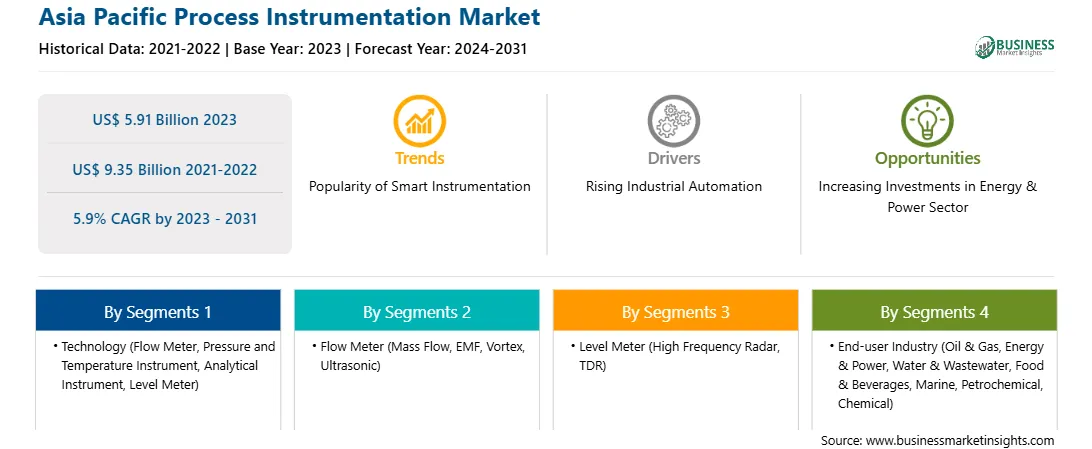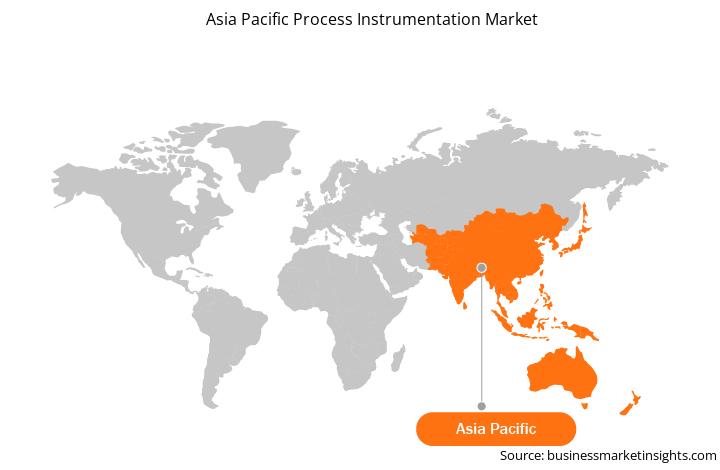The Asia Pacific process Instrumentation market size is projected to reach US$ 9.35 billion by 2031 from US$ 5.91 billion in 2023. The market is expected to register a CAGR of 5.9% in 2023-2031.
Rapid industrialization in countries such as India, China, and Vietnam are a significant contributor to the adoption of process instrumentation. Industries such as chemicals, oil & gas, and power generation continue to be large energy consumers. As a result, countries in Asia Pacific are responding to energy efficiency programs with policies and programs to guide specific changes in energy use across sectors. For example, China's economy is energy-intensive due to a huge number of manufacturing industries. The Central Government of China has continued to develop measures to increase building energy efficiency. Energy appliance regulations and labeling, as well as energy service corporations (ESCOs), have all played crucial roles in building energy efficiency. China's 14th Five-Year Plan (2021-2025) contains a mandatory national target to lower energy intensity by 13.5% below 2020 levels by 2025. Also, Jaona's New Strategic Energy Plan aims to achieve 62 million KLOE energy savings, which requires a further 40% efficiency improvement from 2013 to 2030.
Governments of various countries across Asia Pacific are investing in the energy & power sector. For example, in January 2024, the Central Committee of the Politburo of Vietnam, the top government body of the Communist Party of Vietnam, issued resolution no. 55-NQ/TW on February 11, 2020, on Strategic Energy Orientation until 2030 with Vision 2045. This document defined that installed capacity by 2030 is projected to be 125-130GW, which will double its capacity in 10 years. According to Vietnam's Eight National Power Development Plan (PDP8), the total power capacity installed by 2030 will be ~146,000 MW and account for more than 416,000 MW by 2045. The proposed capacity that coal accounts for approximately 30,000 MW of power generation by 2030. As coal's role in power generation diminishes, solar, natural gas, and wind are likely to account for major sources of energy.
The chemicals & energy industry in Singapore has achieved significant global standing, ranking among the top 10 worldwide and emerging as the 9th largest exporter of chemicals in 2022, as per the World Trade Statistical Review 2023. This growth in the chemicals & energy sector in Singapore is attributed to the increasing demand for process instrumentation and the growing importance of energy efficiency and cost optimization in the country. As the industry continues to further expand its global footprint, the demand for advanced process instrumentation solutions is expected to rise, reflecting the country's rapid economic growth and the industry's commitment to enhancing operational efficiency and sustainability. Process instrumentation involves a variety of technologies and solutions designed to enhance process control and efficiency in diverse industries across Singapore. This market is driven by advancements in technology, rising requirements for process control systems, and the increasing emphasis on energy efficiency and cost-effectiveness. The implementation of process instrumentation equipment offers advantages such as enhanced product quality, reduced emissions, decreased human errors, and cost efficiencies.
ABB Ltd.; Emerson Electric Co.; Honeywell International Inc.; Brooks Instrument; Schneider Electric; Siemens; Yokogawa Electric Corporation; Endress+Hauser Group Services AG; Metso Corporation; and Fuji Electric Co, Ltd are among the prominent players profiled in the Asia Pacific process instrumentation market. The Asia Pacific process instrumentation market report emphasizes the key factors driving the market and prominent players' developments.
The overall Asia Pacific process instrumentation market size has been derived using both primary and secondary sources. Exhaustive secondary research has been conducted using internal and external sources to obtain qualitative and quantitative information related to the. The process also helps obtain an overview of Asia Pacific process instrumentation market with respect to all the market segments. Also, multiple primary interviews have been conducted with industry participants to validate the data and gain analytical insights. This process includes industry experts such as VPs, business development managers, market intelligence managers, and national sales managers, along with external consultants such as valuation experts, research analysts, and key opinion leaders, specializing in the Asia Pacific process instrumentation market. The Asia Pacific process instrumentation market forecast can help stakeholders in this marketplace plan their growth strategies.
Strategic insights for the Asia Pacific Process Instrumentation provides data-driven analysis of the industry landscape, including current trends, key players, and regional nuances. These insights offer actionable recommendations, enabling readers to differentiate themselves from competitors by identifying untapped segments or developing unique value propositions. Leveraging data analytics, these insights help industry players anticipate the market shifts, whether investors, manufacturers, or other stakeholders. A future-oriented perspective is essential, helping stakeholders anticipate market shifts and position themselves for long-term success in this dynamic region. Ultimately, effective strategic insights empower readers to make informed decisions that drive profitability and achieve their business objectives within the market.

| Report Attribute | Details |
|---|---|
| Market size in 2023 | US$ 5.91 Billion |
| Market Size by 2031 | US$ 9.35 Billion |
| Global CAGR (2023 - 2031) | 5.9% |
| Historical Data | 2021-2022 |
| Forecast period | 2024-2031 |
| Segments Covered |
By Technology
|
| Regions and Countries Covered | Asia-Pacific
|
| Market leaders and key company profiles |
The geographic scope of the Asia Pacific Process Instrumentation refers to the specific areas in which a business operates and competes. Understanding local distinctions, such as diverse consumer preferences (e.g., demand for specific plug types or battery backup durations), varying economic conditions, and regulatory environments, is crucial for tailoring strategies to specific markets. Businesses can expand their reach by identifying underserved areas or adapting their offerings to meet local demands. A clear market focus allows for more effective resource allocation, targeted marketing campaigns, and better positioning against local competitors, ultimately driving growth in those targeted areas.

The List of Companies - Asia Pacific Process Instrumentation Market
The Asia Pacific Process Instrumentation Market is valued at US$ 5.91 Billion in 2023, it is projected to reach US$ 9.35 Billion by 2031.
As per our report Asia Pacific Process Instrumentation Market, the market size is valued at US$ 5.91 Billion in 2023, projecting it to reach US$ 9.35 Billion by 2031. This translates to a CAGR of approximately 5.9% during the forecast period.
The Asia Pacific Process Instrumentation Market report typically cover these key segments-
The historic period, base year, and forecast period can vary slightly depending on the specific market research report. However, for the Asia Pacific Process Instrumentation Market report:
The Asia Pacific Process Instrumentation Market is populated by several key players, each contributing to its growth and innovation. Some of the major players include:
The Asia Pacific Process Instrumentation Market report is valuable for diverse stakeholders, including:
Essentially, anyone involved in or considering involvement in the Asia Pacific Process Instrumentation Market value chain can benefit from the information contained in a comprehensive market report.